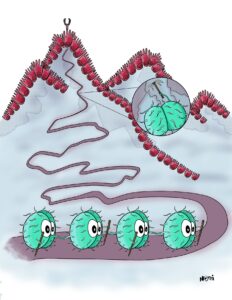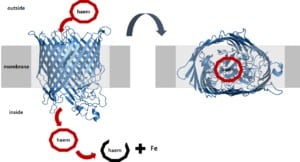To protect themselves from harsh environments, bacteria build shielding biofilm houses. After a while, such a biofilm house becomes old and crumbling. This is when bacteria need to break their biofilms to free themselves from them.
And this process is very interesting to researchers. It tells them how bacteria move in the environment, advance their populations and evolve in general. So, here we explain one mechanism of how bacteria break biofilms.
The bacterium Desulfovibrius vulgaris likes water pipes
As you might know, bacteria are basically everywhere. And they like to build their biofilm houses on pretty much any surface they can find. Be it in or on our bodies or somewhere in nature and the environment.
For example, the bacterium Desulfovibrio vulgaris likes to live on metallic surfaces in the soil. These could be water systems or pipelines that are wet and warm.
Here, the bacterium builds its biofilm house to be protected from the surrounding. Now, Desulfovibrio vulgaris can use the metal from the pipe to gain energy, so it “breathes” the metal. But this metabolic activity leads to the metal pipes corroding or rusting.
And when these metal pipes start corroding, they stop functioning properly which can lead to some serious health issues. So, researchers decided to look into how these bacteria build and break their biofilms.
Bacteria build and break biofilms
The researchers looked at the genes of Desulfovibrio vulgaris with bioinformatic tools. And they found some genes that the bacterium uses to produce less biofilm. Researchers already know some of these genes from other bacteria. Here, these genes also prevented the bacteria from producing a lot of biofilm.
So, the researchers decided on one of these genes and looked at them in more detail. They found that the gene produced a specific enzyme, which is a protein with a special activity.
And in this case, the enzyme’s activity was that it works like a scissor and breaks the biofilms of Desulfovibrio vulgaris. But the researchers also found that this scissor can break the biofilms of other bacteria.
Scientists have always tried to find some kinds of scissors in bacteria that can break biofilms. However, they usually focused on biofilms formed by bacteria in hospital settings. Now, they finally found a new pair of such scissors made by bacteria that live in the environment.

Why do bacteria produce scissors?
Do they not like living in their biofilm houses?
To answer this question, we need to understand that the bacterial biofilm lifestyle works as a cycle. Bacteria build biofilms and use them as houses. As soon as nutrients are scarce or there are too many bacteria within a biofilm, some bacteria break the biofilms to cut themselves loose.
For this, bacteria need to break down parts of their biofilm houses for which they use their special scissors. After cutting themselves free from the biofilm, they start swimming and looking for a new place to live. Once they found it, they will settle down and build a new biofilm house.
By discovering these new kinds of scissors, scientists now have novel tools to combat bacterial biofilms. These tools could inhibit bacterial biofilms in many different settings like the environment or in hospitals.










